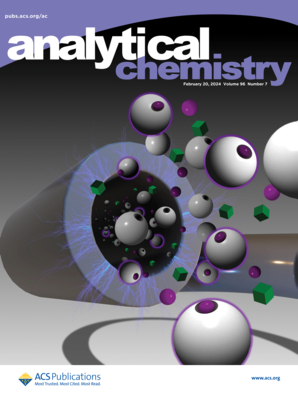Single-Site Iridium Catalyst on Metal–Organic Framework as Light-Responsive Oxidase-Like Nanozyme with High Stability for Colorimetric Detection of Antioxidant Capacity
IF 6.7
1区 化学
Q1 CHEMISTRY, ANALYTICAL
引用次数: 0
Abstract
The design and synthesis of advanced artificial enzymes are essential for developing promising surrogates for natural enzymes. Herein, we reported an efficient and facile strategy for the synthesis of a single-site iridium catalyst on a metal–organic framework (UiO-67@Ir) as a light-responsive oxidase-like nanozyme, in which UiO-67 was utilized as a host template and the iridium(III) complex was utilized as a photosensitizer with a light-responsive property. A single-site iridium catalyst on UiO-67@Ir by the coordination of the Ir (III) complex with the nitrogen atom of UiO-67 is confirmed by X-ray photoelectron spectroscopy and aberration-corrected atomic-resolution high-angle annular dark-field scanning transmission electron microscopy. The UiO-67@Ir possesses remarkable light-responsive oxidase-like activity and good cycle and storage stability. Excellent catalytic activity toward the oxidation of 3,3′,5,5′-tetramethylbenzidine (TMB) was obtained with 0.204 mM of Michaelis–Menten constant (Km) due to its large surface areas and abundant active sites. TMB was oxidized by UiO-67@Ir in the presence of O2 under light irradiation through the formation of both •OH and O2•– by type I photosensitization processes (electron transfer) and the formation of 1O2 by type II photosensitization processes (energy transfer). Moreover, a sensitive colorimetric method was developed for the detection of antioxidants with a detection limit of 0.6, 0.5, and 0.3 μM for ascorbic acid, glutathione, and cysteine, respectively. The total antioxidant capacity in fruit and drink samples were analyzed with desirable results. This study not only enlightens the novel nanozyme designing strategies but also suggests its good analytical performance in colorimetric sensing.

求助全文
约1分钟内获得全文
求助全文
来源期刊

Analytical Chemistry
化学-分析化学
CiteScore
12.10
自引率
12.20%
发文量
1949
审稿时长
1.4 months
期刊介绍:
Analytical Chemistry, a peer-reviewed research journal, focuses on disseminating new and original knowledge across all branches of analytical chemistry. Fundamental articles may explore general principles of chemical measurement science and need not directly address existing or potential analytical methodology. They can be entirely theoretical or report experimental results. Contributions may cover various phases of analytical operations, including sampling, bioanalysis, electrochemistry, mass spectrometry, microscale and nanoscale systems, environmental analysis, separations, spectroscopy, chemical reactions and selectivity, instrumentation, imaging, surface analysis, and data processing. Papers discussing known analytical methods should present a significant, original application of the method, a notable improvement, or results on an important analyte.
 求助内容:
求助内容: 应助结果提醒方式:
应助结果提醒方式:


